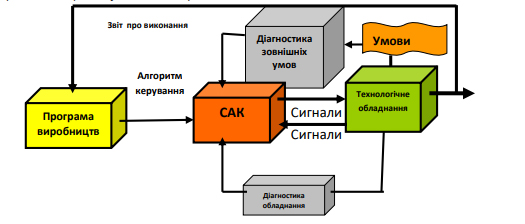КЛАСИФІКАЦІЯ І АНАЛІЗ ТЕХНОЛОГІЧНИХ МАШИН ЗА ХАРАКТЕРОМ ВЗАЄМОДІЇ ЇХ РОБОЧИХ І ІНФОРМАЦІЙНИХ ПРОЦЕСІВ
Ключові слова:
інтелектуальна виробнича система, автоматична пакувальна машина, інтелектуальне виробництво, цифрова модель, автоматизована система керування, інформаційний процес, робочий процес, адаптивна система керуванняАнотація
У статті описано деякі проблемні питання, що стосуються аналізу і класифікації технологічних машин і показані можливі шляхи підвищення їх досконалості при проектуванні на базі використання останніх досягнень інтелектуального виробництва, розвитку мехатроніки і цифрового моделювання. Метою роботи є удосконалення методів досягнення заданого рівня якості технологічного обладнання ще на стадії їх проектування, а також формування нового принципу прогнозування якості машин по параметру керованості.
Посилання
Pavlevich, A.L., Staroverov, N.N., & Heathrich, D.P. (2018). An effective platform for applied research and comprehensive numerical modeling based on ANSYS solutions. CAD / CAM / CAE Observer, 3 (119), 70-75.
Poduraev, Yu.V. (2007). Mechatronics: basics, methods, application. Moscow «Mechanical Engineering».
Rastorguev, G.A., & Rogov, V.A. (2009). Prospects for the Development of Technological Processes in Mechanical Engineering. Technology of Mechanical Engineering, 2, 68-71.
Timchenko, A.A. (2003). Fundamentals of system design and system analysis of complex objects. Kyiv: Lybid.
Ulyanov, V. (2008). Classification of equipment for packaging products in heat-sealed packages. PACKAGE, 2.
Yakhno, O.M., Uzunov, A.V., & Lugovskaya, A.F. (2008). Introduction to Mechatronics. Kiev.
Banaszak, Z., & Pisz, I. (2003). Project–driven production flow management. In. Project Driven Manufacturing. WNT, Warszawa, 53-71.
Gaines, B., & Norrie, D. (1995). Knowledge systematization in the international IMS research program. 1995 IEEE International Conference on Systems, Man and Cybernetics. Intelligent Systems for the 21st Century,1, 958-963. doi:10.1109/icsmc.1995.537891 (in English).
Gola, A., & Świć, A. (2013). Design of FFMS Storage Subsystem Using Computer Simulation Method. Actual Problems of Economics, 4(142), 312-318.
Goldman, S.L., Nagel, R.N., & Preiss, K. (1995). Agile competitors and virtual organizations: strategies for enriching the customer. N.Y.: Van Nostrand Reinhold.
Groover, M.P., & Zimmers, E.W. (1984). CAD/CAM: computer-aided design and manufacturing. New Jersey: Prentice-Hall.
Camarinha-Matos, L.M., Afsarmanesh, H., & Marik, V. (1998). Intelligent Systems for Manufacturing -Multi-agent systems and virtual organizations. Kluwver Academic Publishers, 130, 137-140.
Krouse, J.K. (1982). What Every Engineer Should Know About Computer-Aided Design and Computer-Aided Manufacturing: The CAD/CAM Revolution. New York, Basel: Marcel Dekker.
Mauricio Armellini &Tim Pike. (2019). Bank Underground . Bank of England.
Palchevsky, B., Swic, А., & Krestianpol, H. (2015). Computer integrated designing of flexible manufacturing systems. Lublin University of Technology, Lublin.
Palchevskyi, B., Swic, A., & Krestyanpol, H. (2018). Increasing efficiency of flexible manufacturing systems based on computer product grouping. Advances in Science and Technology Research Journal, 12 (2), 6–10 - DOI: 10.12913/22998624/92093
Policymaker’s, A. (30 November, 2016). Guide to Smart Manufacturing.Information Technology & Innovation Foundation (ITIF). Retrieved from
https://www.itif.org/publications/2016/11/30/ policymakers-guide-smart manufacturing.
Prasanth, S. P. Pramod, V.R., & Jagathy Raj, V. P. (2013). Barriers in TPM Implementation in Industries. International Journal of Scientific & Technology Research. 2, (5), 28-33. (in English).
Romero, D., Stahre,J., Wuest, T., Noran, O., & Bernus, P. (October, 2016). Åsa FastBerglund and Dominic Gorecky, Towards an Operator 4.0 Typology: A HumanCentric Perspective on the Fourth Industrial Revolution Technologies, International Conference on Computers and Industrial Engineering (CIE46) Proceedings, Tianjin, China.
Schwaninger, M. (2009). Intelligent Organizations. Powerful Models for Systemic Management. Springer-Verlag, Berlin: Heidelberg.
Tolio, T. (2009). Design of Flexible Production Systems. Methodologies and Tools. Springer-Verlag, Berling: Heidelberg.


